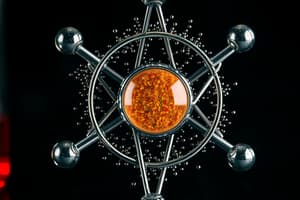Podcast
Questions and Answers
Who is credited with proposing the modern atomic theory?
Who is credited with proposing the modern atomic theory?
- A.Lavoisier
- John Dalton (correct)
- Proust
- None of the above
What is the law of conservation of matter stating?
What is the law of conservation of matter stating?
- The total mass of the reactants is greater than the total mass of the products.
- The total mass of the reactants is less than the total mass of the products.
- The total mass of the products is greater than the total mass of the reactants.
- The total mass of the products must equal the total mass of the reactants. (correct)
What is the result when 10 grams of (\ce{CaCO3}) is heated?
What is the result when 10 grams of (\ce{CaCO3}) is heated?
- 4.4 g of \(\ce{CO2}\) and 5.6 g of \(\ce{CaO}\) (correct)
- 8.8 g of \(\ce{CO2}\) and 9.9 g of \(\ce{CaO}\)
- 6.6 g of \(\ce{CO2}\) and 7.7 g of \(\ce{CaO}\)
- 2.2 g of \(\ce{CO2}\) and 3.3 g of \(\ce{CaO}\)
What happens to the matter when wood burns?
What happens to the matter when wood burns?
What is the significance of the law of conservation of mass in a campfire?
What is the significance of the law of conservation of mass in a campfire?
What is the major contribution of A.Lavoisier to the field of chemistry?
What is the major contribution of A.Lavoisier to the field of chemistry?
What is the central idea expressed in the concept of 'nothing comes from nothing'?
What is the central idea expressed in the concept of 'nothing comes from nothing'?
What is the percentage of oxygen in a sample of pure water by mass?
What is the percentage of oxygen in a sample of pure water by mass?
What is the main idea behind the Law of Conservation of Matter?
What is the main idea behind the Law of Conservation of Matter?
What is true about the Law of Definite Proportions?
What is true about the Law of Definite Proportions?
What is an example of a substance that can be made from hydrogen and oxygen, besides water?
What is an example of a substance that can be made from hydrogen and oxygen, besides water?
What is not true about the Law of Definite Proportions?
What is not true about the Law of Definite Proportions?




